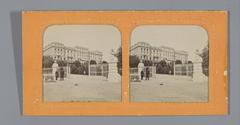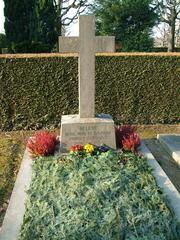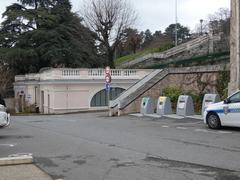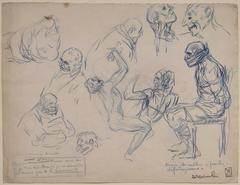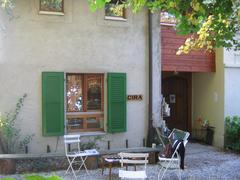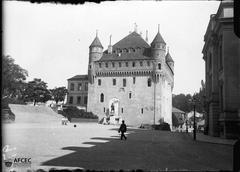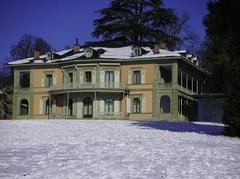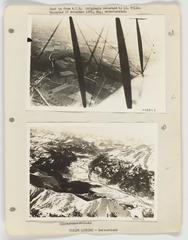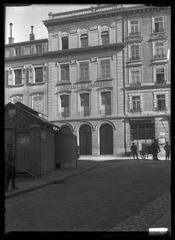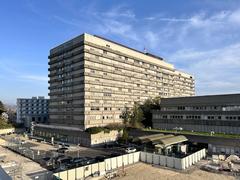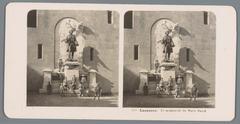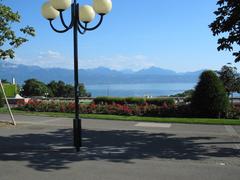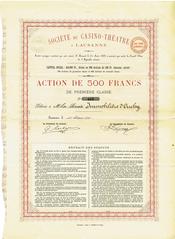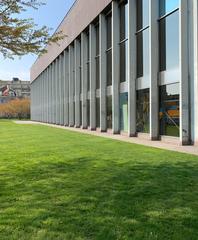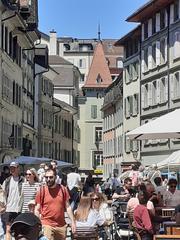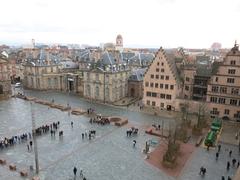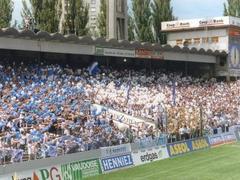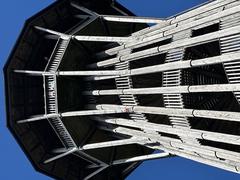Guide to Visiting Musée Olympique in Lausanne, Switzerland
Date: 18/07/2024
Introduction
Nestled in the scenic city of Lausanne, Switzerland, the Musée Olympique stands as a beacon of the Olympic spirit and history. This museum is not just a repository of artifacts but a celebration of the values and ideals that underpin the Olympic movement, offering a comprehensive exploration of the Games’ history, cultural significance, and technological innovations. Established on June 23, 1993, by the visionary Juan Antonio Samaranch, then-President of the International Olympic Committee (IOC), the museum’s inauguration coincided with the 99th anniversary of the IOC’s founding. Designed by the renowned architect Pedro Ramírez Vázquez, the building itself is a marvel, symbolizing the fluidity and dynamism of the Olympic spirit with its modern architectural elements seamlessly blending into the picturesque landscape of Lake Geneva. Visitors to the Musée Olympique can immerse themselves in a rich tapestry of exhibits—from ancient artifacts to cutting-edge multimedia presentations—that bring the storied past and vibrant present of the Olympic Games to life. This guide aims to provide detailed and practical information for potential visitors, covering everything from visiting hours and ticket prices to the unique educational programs and temporary exhibitions that make the museum a must-visit destination for sports enthusiasts and curious travelers alike.
Table of Contents
- Introduction
- History and Origins
- Architectural Design
- Visitor Information
- Collections and Exhibits
- Cultural Significance
- Technological Innovations
- Educational Programs
- Visitor Experience and Amenities
- Impact and Recognition
- Future Prospects
- Nearby Attractions
- Getting There
- Final Tips
- FAQ
- Conclusion
- Sources
Exploring the Musée Olympique - A Complete Guide
History and Origins
The idea for the museum was conceived by Juan Antonio Samaranch, the then-President of the International Olympic Committee (IOC), who envisioned a place where the rich history and cultural significance of the Olympics could be preserved and celebrated. The museum was officially inaugurated on June 23, 1993, coinciding with the 99th anniversary of the founding of the IOC (Olympic.org).
Architectural Design
The museum’s design was the brainchild of Pedro Ramírez Vázquez, an architect known for his work on the Estadio Azteca in Mexico City. The building itself is a marvel of modern architecture, seamlessly blending with the surrounding landscape of Lake Geneva. The structure is designed to symbolize the Olympic spirit, with its fluid lines and open spaces representing the dynamism and inclusivity of the Games (ArchDaily).
Visitor Information
Visiting Hours
The Musée Olympique is open every day except Mondays. From May to October, it is open from 9 AM to 6 PM. From November to April, it is open from 10 AM to 6 PM.
Tickets
General admission tickets cost CHF 18 for adults, CHF 10 for students and seniors, and free for children under 16. Discounts are available for groups and families.
Tips
It is recommended to purchase tickets in advance, especially during peak tourist seasons. Guided tours are available and can enhance the visitor experience.
Collections and Exhibits
Permanent Exhibitions
The Olympic World
The “Olympic World” section offers a comprehensive journey through the history of the Olympic Games, from their ancient origins in Greece to the modern era. This exhibit is divided into several thematic areas, each focusing on different aspects of the Games. Visitors can explore the evolution of the Olympic movement, the role of the International Olympic Committee (IOC), and the impact of the Games on global culture and society. Interactive displays and multimedia presentations provide an engaging experience, allowing visitors to delve into the stories of legendary athletes and iconic moments in Olympic history.
The Olympic Spirit
“The Olympic Spirit” exhibit celebrates the values and ideals that underpin the Olympic movement. This section highlights the principles of excellence, friendship, and respect that guide the Games and inspire athletes worldwide. Visitors can learn about the Olympic Charter, the role of fair play, and the importance of sportsmanship. The exhibit also features personal stories of athletes who have exemplified these values, offering a deeper understanding of the human spirit behind the competition.
The Olympic Games
This exhibit focuses on the Games themselves, showcasing the evolution of sports, equipment, and technology over the years. Visitors can explore the development of various Olympic sports, from athletics and swimming to more recent additions like skateboarding and surfing. The exhibit includes a vast collection of memorabilia, such as medals, torches, and uniforms, providing a tangible connection to the history of the Games. Interactive displays allow visitors to test their skills in virtual sports simulations, offering a hands-on experience of the Olympic spirit.
Temporary Exhibitions
In addition to its permanent collection, the Musée Olympique hosts a series of temporary exhibitions that explore different aspects of the Olympic Games and related themes. These exhibitions often feature rare artifacts, multimedia installations, and interactive displays that provide a fresh perspective on the Olympic experience. Recent exhibitions have covered topics such as the history of the Winter Games, the role of women in the Olympics, and the impact of technology on sports (Olympic.org).
Cultural Significance
The Musée Olympique is not just a repository of artifacts; it is a cultural institution that plays a vital role in promoting the values of the Olympic Movement. The museum’s exhibits are designed to educate visitors about the history of the Games, the achievements of athletes, and the cultural and social impact of the Olympics. Through its educational programs and temporary exhibitions, the museum fosters a deeper understanding of the Olympic ideals of excellence, friendship, and respect (Olympic.org).
Technological Innovations
One of the key features of the Musée Olympique is its use of cutting-edge technology to create an immersive and interactive visitor experience. The museum employs a range of multimedia tools, including touchscreens, virtual reality, and augmented reality, to bring the history of the Olympics to life. These technological innovations allow visitors to engage with the exhibits in a more meaningful and interactive way, enhancing their understanding and appreciation of the Olympic heritage (Olympic.org).
Educational Programs
Workshops and Guided Tours
The museum offers a variety of educational programs aimed at different age groups, from schoolchildren to adults. These programs include guided tours, workshops, and interactive activities that provide a hands-on learning experience. The museum also collaborates with schools and educational institutions to develop curriculum-based programs that align with the educational standards and objectives of different countries (Olympic.org).
Special Events and Lectures
The museum regularly hosts special events, lectures, and panel discussions featuring experts, athletes, and historians. These events provide unique opportunities for visitors to engage with the Olympic movement and learn from those who have been directly involved in the Games. Topics covered in these events range from the history and evolution of the Olympics to contemporary issues such as sustainability, inclusivity, and the future of sports. Special events and lectures at Musée Olympique offer a dynamic and enriching experience, allowing visitors to deepen their understanding of the Olympic movement and its global impact (Olympic.org).
Visitor Experience and Amenities
The Olympic Park
The Olympic Park surrounding the museum is an attraction in its own right, featuring a variety of outdoor exhibits and installations. Visitors can explore sculptures, monuments, and art installations that celebrate the Olympic spirit and the achievements of athletes. The park also includes a running track, a long jump pit, and other sports facilities where visitors can engage in physical activities and experience the thrill of competition. The beautifully landscaped gardens and stunning views of Lake Geneva make the Olympic Park a perfect place for a leisurely stroll or a picnic (Olympic.org).
Interactive Experiences
Virtual Reality and Simulations
Musée Olympique offers a range of interactive experiences that allow visitors to immerse themselves in the world of the Olympics. Virtual reality (VR) stations provide a unique opportunity to experience the Games from the perspective of an athlete, offering simulations of various sports and events. Visitors can try their hand at archery, fencing, or even bobsleigh, gaining a deeper appreciation for the skills and dedication required to compete at the highest level. These interactive experiences are designed to be both educational and entertaining, making them a highlight for visitors of all ages (Olympic.org).
Multimedia Presentations
Throughout the museum, multimedia presentations and interactive displays provide engaging and informative content on the history and significance of the Olympic Games. These presentations often include rare footage, interviews with athletes, and behind-the-scenes insights into the organization and execution of the Games. Visitors can explore the stories of individual athletes, learn about the challenges and triumphs of hosting the Games, and gain a deeper understanding of the cultural and social impact of the Olympics (Olympic.org).
Dining and Refreshments
The museum features a café, the TOM Café, which offers a variety of meals, snacks, and beverages. The café boasts stunning views of Lake Geneva and the Alps, making it a perfect spot to relax and enjoy a meal after exploring the exhibits. The menu includes a range of options, from light snacks to full meals, catering to various dietary preferences.
Souvenirs and Shopping
The museum shop offers a wide range of Olympic-themed souvenirs, including clothing, accessories, books, and memorabilia. It is an excellent place to pick up a memento of your visit or a gift for friends and family. The shop is located near the entrance and is open during museum hours.
Photography and Etiquette
Photography is allowed in most areas of the museum, but the use of flash and tripods is prohibited to protect the exhibits. Be mindful of other visitors and avoid blocking pathways or exhibits while taking photos.
Impact and Recognition
Since its opening, the Musée Olympique has received numerous accolades and awards for its innovative design and educational programs. It has been recognized as one of the leading sports museums in the world and has attracted millions of visitors from around the globe. The museum’s success is a testament to its ability to inspire and educate people about the enduring legacy of the Olympic Games (Olympic.org).
Future Prospects
Looking ahead, the Musée Olympique continues to evolve and innovate to meet the changing needs and expectations of its visitors. The museum is committed to expanding its collection, enhancing its exhibits, and developing new educational programs that reflect the latest trends and developments in the world of sports. As the custodian of the Olympic heritage, the Musée Olympique will continue to play a vital role in preserving and promoting the values of the Olympic Movement for future generations (Olympic.org).
Nearby Attractions
While in Lausanne, visitors can also explore other historical sites such as the Lausanne Cathedral, the Collection de l’Art Brut, and the Ouchy Promenade. These attractions offer a deeper insight into the rich cultural heritage of the region.
Getting There
The Musée Olympique is easily accessible by public transportation. The closest metro station is Ouchy-Olympique on the M2 line, which is a short walk from the museum. There are also several bus lines that stop near the museum. For those driving, there is a parking lot available, but spaces can be limited, especially during peak times. For more detailed directions and transportation options, visit the museum’s location page.
Final Tips
- Plan Ahead: Check the museum’s website for any special exhibitions or events that may be taking place during your visit.
- Stay Hydrated: Bring a water bottle, especially if you plan to spend several hours exploring the museum.
- Comfortable Footwear: Wear comfortable shoes, as there is a lot to see and you will be on your feet for most of the visit.
- Respect the Rules: Follow the museum’s guidelines and respect the exhibits to ensure a pleasant experience for all visitors.
FAQ
-
What are the visiting hours of Musée Olympique? The museum is open every day except Mondays. From May to October, it is open from 9 AM to 6 PM. From November to April, it is open from 10 AM to 6 PM.
-
How much are the tickets for Musée Olympique? General admission tickets cost CHF 18 for adults, CHF 10 for students and seniors, and free for children under 16.
-
Is the museum accessible for visitors with disabilities? Yes, the Musée Olympique is fully accessible for visitors with disabilities.
Conclusion
The Musée Olympique in Lausanne offers a unique and enriching experience that transcends the traditional boundaries of a museum visit. With its extensive collections, innovative exhibits, and immersive technological features, it provides a comprehensive journey through the history and cultural impact of the Olympic Games. The museum not only preserves the rich legacy of the Olympics but also actively promotes the values of excellence, friendship, and respect through its educational programs and temporary exhibitions. Visitors can enjoy a well-rounded experience, from engaging with interactive displays and virtual reality simulations to exploring the beautifully landscaped Olympic Park and dining at the TOM Café with stunning views of Lake Geneva. As the museum continues to evolve and innovate, it remains a vital institution dedicated to inspiring and educating future generations about the enduring legacy of the Olympic Movement. Whether you are a sports aficionado or simply a curious traveler, a visit to the Musée Olympique promises to be a memorable and enlightening experience.
